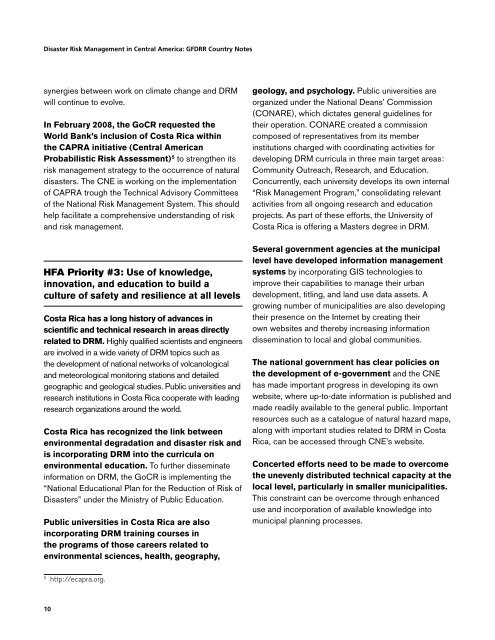Disaster Risk Management in Central America: GFDRR Country Notes
Disaster Risk Management in Central America: GFDRR Country Notes
Disaster Risk Management in Central America: GFDRR Country Notes
You also want an ePaper? Increase the reach of your titles
YUMPU automatically turns print PDFs into web optimized ePapers that Google loves.
<strong>Disaster</strong> <strong>Risk</strong> <strong>Management</strong> <strong>in</strong> <strong>Central</strong> <strong>America</strong>: <strong>GFDRR</strong> <strong>Country</strong> <strong>Notes</strong><br />
synergies between work on climate change and DRM<br />
will cont<strong>in</strong>ue to evolve.<br />
In February 2008, the GoCR requested the<br />
World Bank’s <strong>in</strong>clusion of Costa Rica with<strong>in</strong><br />
the CAPRA <strong>in</strong>itiative (<strong>Central</strong> <strong>America</strong>n<br />
Probabilistic <strong>Risk</strong> Assessment) 5 to strengthen its<br />
risk management strategy to the occurrence of natural<br />
disasters. The CNE is work<strong>in</strong>g on the implementation<br />
of CAPRA trough the Technical Advisory Committees<br />
of the National <strong>Risk</strong> <strong>Management</strong> System. This should<br />
help facilitate a comprehensive understand<strong>in</strong>g of risk<br />
and risk management.<br />
HFA Priority #3: Use of knowledge,<br />
<strong>in</strong>novation, and education to build a<br />
culture of safety and resilience at all levels<br />
Costa Rica has a long history of advances <strong>in</strong><br />
scientific and technical research <strong>in</strong> areas directly<br />
related to DRM. Highly qualified scientists and eng<strong>in</strong>eers<br />
are <strong>in</strong>volved <strong>in</strong> a wide variety of DRM topics such as<br />
the development of national networks of volcanological<br />
and meteorological monitor<strong>in</strong>g stations and detailed<br />
geographic and geological studies. Public universities and<br />
research <strong>in</strong>stitutions <strong>in</strong> Costa Rica cooperate with lead<strong>in</strong>g<br />
research organizations around the world.<br />
Costa Rica has recognized the l<strong>in</strong>k between<br />
environmental degradation and disaster risk and<br />
is <strong>in</strong>corporat<strong>in</strong>g DRM <strong>in</strong>to the curricula on<br />
environmental education. To further dissem<strong>in</strong>ate<br />
<strong>in</strong>formation on DRM, the GoCR is implement<strong>in</strong>g the<br />
“National Educational Plan for the Reduction of <strong>Risk</strong> of<br />
<strong>Disaster</strong>s” under the M<strong>in</strong>istry of Public Education.<br />
Public universities <strong>in</strong> Costa Rica are also<br />
<strong>in</strong>corporat<strong>in</strong>g DRM tra<strong>in</strong><strong>in</strong>g courses <strong>in</strong><br />
the programs of those careers related to<br />
environmental sciences, health, geography,<br />
geology, and psychology. Public universities are<br />
organized under the National Deans’ Commission<br />
(CONARE), which dictates general guidel<strong>in</strong>es for<br />
their operation. CONARE created a commission<br />
composed of representatives from its member<br />
<strong>in</strong>stitutions charged with coord<strong>in</strong>at<strong>in</strong>g activities for<br />
develop<strong>in</strong>g DRM curricula <strong>in</strong> three ma<strong>in</strong> target areas:<br />
Community Outreach, Research, and Education.<br />
Concurrently, each university develops its own <strong>in</strong>ternal<br />
“<strong>Risk</strong> <strong>Management</strong> Program,” consolidat<strong>in</strong>g relevant<br />
activities from all ongo<strong>in</strong>g research and education<br />
projects. As part of these efforts, the University of<br />
Costa Rica is offer<strong>in</strong>g a Masters degree <strong>in</strong> DRM.<br />
Several government agencies at the municipal<br />
level have developed <strong>in</strong>formation management<br />
systems by <strong>in</strong>corporat<strong>in</strong>g GIS technologies to<br />
improve their capabilities to manage their urban<br />
development, titl<strong>in</strong>g, and land use data assets. A<br />
grow<strong>in</strong>g number of municipalities are also develop<strong>in</strong>g<br />
their presence on the Internet by creat<strong>in</strong>g their<br />
own websites and thereby <strong>in</strong>creas<strong>in</strong>g <strong>in</strong>formation<br />
dissem<strong>in</strong>ation to local and global communities.<br />
The national government has clear policies on<br />
the development of e-government and the CNE<br />
has made important progress <strong>in</strong> develop<strong>in</strong>g its own<br />
website, where up-to-date <strong>in</strong>formation is published and<br />
made readily available to the general public. Important<br />
resources such as a catalogue of natural hazard maps,<br />
along with important studies related to DRM <strong>in</strong> Costa<br />
Rica, can be accessed through CNE’s website.<br />
Concerted efforts need to be made to overcome<br />
the unevenly distributed technical capacity at the<br />
local level, particularly <strong>in</strong> smaller municipalities.<br />
This constra<strong>in</strong>t can be overcome through enhanced<br />
use and <strong>in</strong>corporation of available knowledge <strong>in</strong>to<br />
municipal plann<strong>in</strong>g processes.<br />
5<br />
http://ecapra.org.<br />
10
















